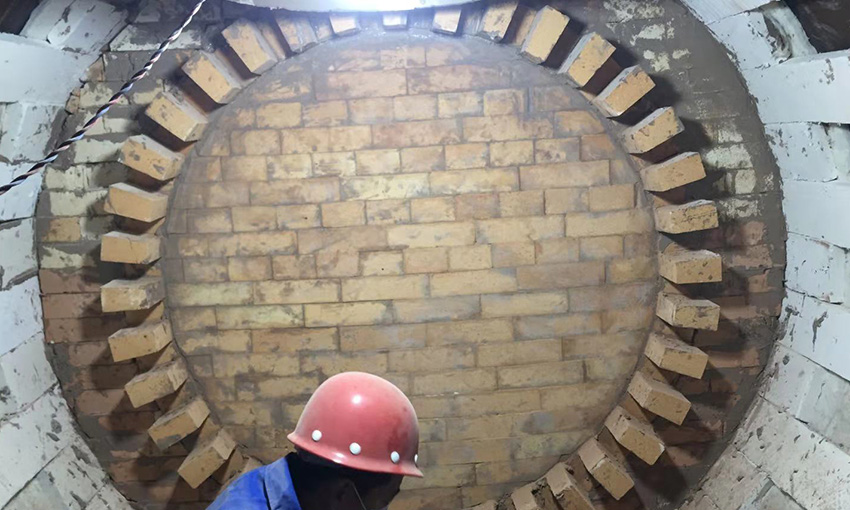What's Refractory Brick Expansion Joint Mean
That is, refractory brick and fire brick need to be bonded or filled with materials. Generally, the high-temperature refractory mud of the same material is used. If it is dry, the same material as the refractory brick is used to fill the brick joint.

Brick Joint of Refractory Brick Introduction
In the case of refractory brick masonry, there will be large or small gaps between the brick and the brick. The high temperature flame will cause abrasion and erosion to the thermal equipment through the gap, so in order to avoid such things, when the refractory brick is built The same raw materials of refractory mud or dry powder will be used to fill the brick joints and block the erosion and erosion of high temperature flames.
Brick Joint Thickness of Refractory Brick
The thickness of fire brick joint of the industrial furnace masonry refractory brick shall be determined by the juice setting according to the furnace part and production conditions. According to the production practice and the fineness of construction, the thickness of the refractory brick joint of the general industrial furnace masonry refractory brick varies according to the furnace part. Generally, the values ??specified in the figure below should be met. The furnace or part with special requirements for the thickness of the brick of the refractory brick is determined by the juice setting. The center line and elevation control line of the industrial furnace shall be determined by the professional staff according to the juice regulations. Prior to masonry, the size of the masonry should be checked according to the specifications and dimensions of the refractory brick.
Refractory brick masonry method and brick joint requirements
1. The refractory brick masonry method is relatively simple, and the method is divided into dry and wet construction. Dry mud does not need mud, wet mud must use mud.
2. The refractory brick masonry category is the requirement for the fineness of construction, mainly refers to the size of the brick joint. Masonry categories are divided into special categories, engineering categories, II, III, and IV. There are requirements in the general kiln construction drawings. The brickwork of the special type of masonry refractory brick is not more than 0.5 mm, the masonry of the industrial class is not more than 1 mm, the masonry of the second class is not more than 2 mm, and the masonry of the third type is not more than 3 mm, Class IV masonry is larger than 3 mm.
3.If the type of masonry or the size of the fire brick joint is not explicitly required for the drawing, the temperature of each part must be determined according to the nature of the kiln. For refractory bricks, insulated refractory bricks and red bricks, refer to the following regulations (in millimeters).
4.Blast furnace (refractory clay brick or high alumina brick masonry): bottom ≤0.5, hearth ≤0.5, belly and thin fireplace waist ≤l, thick fireplace waist ≤1, furnace cooling box area ≤1.5, above the furnace cooling box ≤ 2, the area of ??the steel brick of the throat is ≤ 3, the top of the furnace is ≤ 2, and the annular masonry around the heat-resistant concrete is ≤ 3.
Blast furnace (carbon block masonry): the thin seam at the bottom of the furnace is ≤2.5, the slant joint at the top of the furnace is ≤1.5, the thin joint of the hearth is ≤2; the thin joint at other parts is ≤2.5, and the protective layer of the carbon block is ≤3.
Hot blast stove: wall ≤ 2, arch and dome ≤ 1.5, bottom ≤ 2.5, diatomite brick masonry ≤ 5, refractory high alumina brick ≤ 2.
Other auxiliary equipment of blast furnace: hot air duct ≤1.5, gas outlet pipe and dust collector ≤2.5, flue bottom and wall ≤3, flue vault ≤2, iron slag ditch ≤2-3, molten iron tank ≤1~ 2.
Electric furnace: flue wall and bottom ≤ 3, flue vault ≤ 2, furnace wall, bottom, furnace cover and hot air passage ≤ 2, furnace burner ≤ 1, heat exchange chamber wall and bottom ≤ 3, heat exchange chamber arch Top ≤ 2, the horizontal joint between the heat exchanger chamber tube brick and the disc brick is ≤ 2; when the movable furnace lid is used without trench brick ≤ 1.5.
Heating furnace and heat treatment furnace: flue wall and bottom ≤ 3, flue arch ≤ 2, furnace wall and bottom ≤ 3, heating section and soaking section wall ≤ 2, magnesia brick and magnesia chrome brick ≤ 2, furnace top And arch ≤ 2, heat exchange chamber wall and bottom ≤ 3, heat exchange chamber arch ≤ 2, heat chamber four-hole lattice brick horizontal joint ≤ 1.
Ring heating furnace: wall, arch and burner ≤ 2, bottom ≤ 3, lightweight clay brick and diatomite brick ≤ 5.
Tunnel kiln: gas burner ≤1, kiln top hanging brick ≤1.5, channel arch, high pressure air jet, kiln inner wall, fuel chamber vault ≤2, kiln bottom passage, heat insulation wall, clay brick exterior wall ≤3.
Downdraft kiln: kiln top and arch ≤ 2, wall ≤ 3, bottom ≤ 4.
Rotary kiln: longitudinal seam ≤ 2, transverse seam ≤ 3.
Blast furnace: the furnace magnesia brick ≤ 1, the furnace clay refractory brick ≤ 2, the furnace body ≤ 2, the furnace top ≤ 3.


